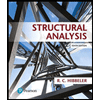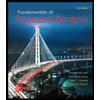Q5/ An open belt connects two flat pulleys. The pulley diameters are 300 mm and 450 mm and the corresponding angles of lap are 160° and 210°. The smaller pulley runs at 200 r.p.m. The coefficient of friction between the belt and pulley is 0.25. It is found that the belt is on the point of slipping when 3 kW is transmitted. To increase the power transmitted two alternatives are suggested, namely (i) increasing the initial tension by 10%, and (i) increasing the coefficient of friction by 10% by the application of a suitable dressing to the beit. Which of these wo methods would be more effective? Find the percentage increase in power possible in each case.
Q5/ An open belt connects two flat pulleys. The pulley diameters are 300 mm and 450 mm and the corresponding angles of lap are 160° and 210°. The smaller pulley runs at 200 r.p.m. The coefficient of friction between the belt and pulley is 0.25. It is found that the belt is on the point of slipping when 3 kW is transmitted. To increase the power transmitted two alternatives are suggested, namely (i) increasing the initial tension by 10%, and (i) increasing the coefficient of friction by 10% by the application of a suitable dressing to the beit. Which of these wo methods would be more effective? Find the percentage increase in power possible in each case.
Chapter2: Loads On Structures
Section: Chapter Questions
Problem 1P
Related questions
Question

Transcribed Image Text:Q5/ An open belt connects two flat pulleys. The puley diameters are 300 mm and 450 mm and the corresponding
angles of lap are 160° and 210°. The smaller pulley runs at 200 r.p.m. The coefficient of friction between the belt
and pulley is 0.25. It is found that the belt is on the point of slipping when 3 kW is transmitted. To increase the
power transmitted two alternatives are suggested, namely (i) increasing the initial tension by 10%, and (i)
increasing the coefficient of friction by 10% by the application of a suitable dressing to the beit. Which of these wo
methods would be more effective? Find the percentage increase in power possible in each case.
Expert Solution
This question has been solved!
Explore an expertly crafted, step-by-step solution for a thorough understanding of key concepts.
Step by step
Solved in 2 steps with 2 images

Knowledge Booster
Learn more about
Need a deep-dive on the concept behind this application? Look no further. Learn more about this topic, civil-engineering and related others by exploring similar questions and additional content below.Recommended textbooks for you


Structural Analysis (10th Edition)
Civil Engineering
ISBN:
9780134610672
Author:
Russell C. Hibbeler
Publisher:
PEARSON

Principles of Foundation Engineering (MindTap Cou…
Civil Engineering
ISBN:
9781337705028
Author:
Braja M. Das, Nagaratnam Sivakugan
Publisher:
Cengage Learning


Structural Analysis (10th Edition)
Civil Engineering
ISBN:
9780134610672
Author:
Russell C. Hibbeler
Publisher:
PEARSON

Principles of Foundation Engineering (MindTap Cou…
Civil Engineering
ISBN:
9781337705028
Author:
Braja M. Das, Nagaratnam Sivakugan
Publisher:
Cengage Learning

Fundamentals of Structural Analysis
Civil Engineering
ISBN:
9780073398006
Author:
Kenneth M. Leet Emeritus, Chia-Ming Uang, Joel Lanning
Publisher:
McGraw-Hill Education


Traffic and Highway Engineering
Civil Engineering
ISBN:
9781305156241
Author:
Garber, Nicholas J.
Publisher:
Cengage Learning